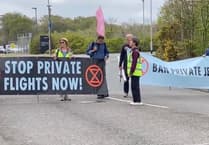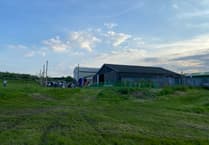Farnborough Airport CEO Simon Geere has faced a volley of questions after unveiling ambitious growth plans that could drastically increase the number of private jets flying over rural parts of Surrey and Hampshire. In an exclusive interview, we threw some more into the mix – both our own and those of readers...
On the eve of the Farnham Maltings consultation drop-in on September 21, we asked readers for questions to put to the airport boss, and you didn’t disappoint. What follows is the result of our conversation with Mr Geere, who openly acknowledges the contentiousness of the proposed expansion – aimed at elevating Farnborough’s annual flight cap from 50,000 to 70,000 and more than doubling weekend flights from 8,900 to 18,900.
“Airport growth tends to polarise views, whether it be at Farnborough or any other airport,” conceded Mr Geere, while underscoring the airport’s commitment to actively listen to the community’s views. And it is not too late to shape the course of the airport’s impending planning application, slated for submission to Rushmoor Borough Council this autumn, he added.
“We recognise people will have concerns, and we hope to be able to address some of those,” said Mr Geere.
The full interview follows below:
Hi Simon. So how would you assess the initial reaction to your plans?
Simon Geere (SG): Pretty mixed, to be honest, which is what I expected. Obviously, we have advocates of the airport and the business. But where people do have do have concerns, they want to express those and we’re here to listen. We understand the impact of the airport can stretch quite widely.
Reader’s question #1: Private planes are reported to be up to 14 times more polluting per passenger than commercial planes and 50 times more polluting than trains. How does Farnborough Airport justify increasing further damage to the planet by doubling flights at weekends?
SG: We accept business aviation has a different profile to commercial aviation. And we’re predominantly a business aviation airport.
There’s always a balance to be struck between environmental impacts and economic benefit. There’s always a trade off, and the right trade off needs to be made. I fully accept that some people don’t accept that trade off. But equally, we and others will see the economic benefits of growth and will want to embrace the opportunity which is really what we’re consulting on.
Today the airport supports directly or indirectly near-on 3,000 jobs and generates £200 million a year for the local economy. So actually there’s a lot of good that comes from the airport’s operation. But equally I accept the environmental impact isn’t necessarily evenly spread across the local area or the wider region. That’s why we need to listen to people carefully as to what their concerns are.
The airport states there is a “forecasted increase in market demand for flights”. How do you measure this demand and who is demanding these flights?
SG: You have to ask what is the market for Farnborough Airport? Well, it’s dictated by two things: our geographic location and proximity to one of the world’s leading capitals, London, and the south east. But also importantly, our market is dictated by the types of flights we’re allowed to handle. We have limits on not only aircraft size, but also the purpose of flights. So we’re not allowed to handle scheduled passenger services or charter flights or freight operations.
So if you have a restriction on the types of flights you can handle and the size of aircraft, you really have only one market and that’s business aviation. That’s your core market.
So when we look at that market, historically, its growth is correlated to the UK’s gross domestic product (GDP), as is most aviation. Historically it’s grown at between two and three per cent, as has GDP. So if we look forward, that market will grow by two to three per cent and track and support GDP growth for the UK.
There’s also a small element over time, where the growth in business aviation will get displaced from commercial passenger airports as they become increasingly capacity constrained. As they prioritise larger commercial airlines, they will focus less on business aviation, and business aviation will need capacity and access into London and the south east.
We’re forecasting just over four per cent growth per annum, which isn’t in my mind unreasonable. In fact, historically, we’ve probably grown at similar levels, maybe just slightly less. But you can see the issue with the airport capacity starting to bite and therefore Farnborough has a role to play in supporting business aviation growth going forward. And that’s consistent with government policy around making best use of airport infrastructure.
Reader’s question #2: Farnborough Airport was originally restricted to 28,000 flights annually with a cap of 2,500 weekend flights. Are the proposed 70,000 flights per year with 18,000 weekend flights the maximum limit for the airport, or is this just a step towards further expansion? If so, what is the ultimate limit?
SG: The main constraint on the capacity for an airport like Farnborough will be airspace, and that will be the case for quite a few airports. We are located in one of the busiest aviation markets in Europe, if not the world, nestled between two very large airports Heathrow and Gatwick. So airspace will, over time, become a premium.
But the government is embarking on an airspace modernisation programme with two objectives, one to make airspace more efficient to facilitate growth over time. But also to try to reduce carbon emissions.
There’s a lot of aircraft following strange and odd routings that could be better choreographed if airspace was designed in a more optimal way.
We think 70,000 movements is, unless you get an awful lot of peak or hourly spreading across the day, a fairly optimal throughput for Farnborough. I think then you do start to hit this airspace issue which, to a degree, is a balance between what’s happening at other airports and what’s happening here. But ultimately we can only put a case forward to get a fair share of that airspace as we move forward.
Why do you need to more than double weekend flights, though? Is that not mainly for leisure travel?
SG: No. When we look at our passenger profile, there is not strong evidence to suggest the weekends are any more leisure-focused than the rest of the week. So the demand at the weekend is as much from our core business aviation market than it is anything else. It’s just that work patterns have changed over time. The working week is no longer Monday to Friday. It’s Monday to Sunday.
So all we’re saying about the weekends is that we need to grow at the weekends at the same rate as we want to grow during the week, no more, no less. And that’s why the proposals we’re consulting on have the weekend cap increasing, but it’s still equivalent to 27 per cent of the annual cap, which is what we currently do today. So we’re just saying everything needs to grow at the same rate to meet market demand. That’s super important.
But in terms of raising the overall target, you are some way short of your existing target of 50,000 currently – operating just over 30,000 flights in 2022. So why increase that to 70,000?
SG: You’re absolutely right, the weekend is a limit that we’re closer to. Look, these planning processes take time. This process could take anywhere from 18 to 24 months or more to find a resolution. The same process would have had to have been followed to address the weekend cap as it would the annual cap. And we forecast that market demand will hit our annual cap by around about 2030. So there was little point in us coming forward with just the weekend cap uplift, going through all the consultation, doing the environmental impact assessment, spending two and a half years to get a resolution on that only to immediately come back and start another process to address our annual cap. So here we’re putting everything together.
The airport has said it is unlikely to reach full capacity until 2040. So is this more about increasing the saleability of Farnborough Airport?
SG: You’re absolutely right and it’s an important point, this growth isn’t going to happen overnight, neither at the weekend or during the weekday. We don’t expect growth to vary much differently from four per cent per annum over the long term. So this is very much what will happen by 2040.
But beyond the economic points around job creation and economic prosperity in the local area or in the wider region, from a business aviation user perspective if you can’t fly into Farnborough, you’ll either go somewhere else, and the economic opportunity will be for someone else to realise and benefit from, or you won’t come in at all to the UK.
So there’s two really important questions. One is locally, do we value and want Farnborough to be the most important and largest business aviation airport in the UK and maintain that pre-eminent position, with all the benefits that’s historically brought? Or do we not?
In that case, other airports could well benefit, other smaller airports, and that traffic will go elsewhere. Or the traffic will be lost completely to the UK and we would argue that will make UK a much less attractive place to do business. It will affect the UK on the international scene in terms of inward investment and make it less competitive.
So there’s a strong UK PLC argument that actually business aviation needs to be supported. Where it’s supported is the next question and Farnborough Airport is in a great position to serve that market and bring all the benefits to the local area.
You talk about Farnborough Airport pumping £200 million a year into the local economy, but how? What does that actually mean materially? How does it benefit your average person in the street and the community around them?
SG: Well, obviously, it puts wages into the local economy. So if you’ve got 3,000 people who are either directly or indirectly, either through our business partners or our supply chains, who have a job that’s connected in some shape or form to the airport’s existence, then you’re obviously creating an income for yourself and your family and you’ll spend that income in the community. That has knock-on beneficial effects for shops and taxi firms and all that type of good stuff.
Our payroll last year, just for the airport group, was around a £14 million. And obviously you can compound that for the likes of Gulfstream, Farnborough International and everybody else based at the airport, so it creates huge economic wealth within the local society. That can’t be underplayed.
Reader’s question #3: Summer Sunday afternoons are now blighted by jets carrying the rich and famous screaming low over our gardens on their way into Farnborough. Are objectors ever listened to and does the airport have any sympathy for those living under this cacophony that has been imposed upon us despite our objections?
SG: We always listen to people’s concerns and it’s important, as part of any of any process and even as an ongoing business, to listen to our community. We fully understand people feel disturbed by noise, and we’re not going to argue they shouldn’t or they don’t. If you feel disturbed you feel disturbed.
But the reality is it’s not rich and famous people on private jets travelling at will. Our core market is business aviation. Now these are travellers who are using smaller, lighter aircraft. There are a number of reasons someone might use business aviation, but for example, you could get a direct flight connection at a time that you might need to travel. Or conversely you might need travel flexibility, which business aviation offers, or equally, you might have a complex travel itinerary. And it really goes to the point that we have a lot of flights that might come in Sunday, leave on leave on a Monday or Tuesday, and vice versa.
We have flights that come in on the Thursday and Friday and leave on a Saturday and Sunday. And you can’t just ringfence the weekend and think that’s a window of the week that isn’t somehow linked to the rest of the week. It absolutely is. And that’s why weekend growth alongside weekday growth is paramount to the future of the airport and the economic benefits it will bring to the local area.
All the proposals we are consulting on are within the 2019 noise budget that was in the Rushmoor Borough Local Plan. I accept there will be more aircraft flying overhead. Absolutely. But aircraft is getting quieter for sure, and that’s why we can grow to 70,000 air movements today and still be within the noise budget that was previously set.
But as I said before, it’s trade off and I fully accept it’s a trade off some people don’t want to make. But equally there are other people providing input to the consultation who believe, as we do, that this is an important issue and something that needs to be supported, not just for the airport, but for the local area and the wider region.
Pre-consultation data from the Civil Aviation Authority (CAA) suggests some rural areas around the airport that used to have about five flights a day over them now have up to 18 an hour. If that’s going to increase even further, can you understand why some people are very concerned?
SG: I can understand why people have concerns and look, it’s not just a noise budget that we have, we also have a number of other controls on us. For example, we don’t operate at night, we have smaller aircraft, we’re not open on Christmas Day and Boxing Day. We have constraints and that’s why our noise footprint is a lot smaller than what you’d have if you if you had a commercial airport, handing a similar number of movements.
I’m not expecting that to allay people’s concerns. I’m just wanting to bring in some relativity to the discussion.
The flight paths were a decision that was undertaken as part of the whole airspace change programme, a long consultation process that started back in 2012. The CAA and government policy guidelines state that flight paths should avoid major conurbations or where major populations are and by default, therefore, are going to fly over quieter areas and that’s why the flight paths are what they are. We consulted on that at length back as part of the airspace change programme. But I fully appreciate that people who live in certain communities might not have experienced quite the same level of perceived disruption as they previously did pre- and post- the airspace change programme.
But equally, some people have benefited from the changes. And obviously we still await the CAA’s final conclusions on the process.
The Post Implementation Review (PIR) for those airspace changes, implemented in February 2020, was due to be published by the CAA in February 2022. The Covid pandemic meant it was delayed and the report was due in August, but it’s still with the CAA. Should you not wait to see what the results of the PIR are before proposing any increases?
The airspace change programme was about a number of issues, but mainly to put in place a controlled and known airspace environment above the airport and above communities, and it obviously had safety benefits. So that was the primary driver of airspace change, not a capacity change.
Look, airspace change and also the wider airspace modernisation programme are things that are running in parallel. We see the proposals we’re consulting on as quite separate. So what we’re saying is look, here’s the market demand opportunity. We believe it’s a good idea for us to be able to accommodate that market, here are the changes, this is the economic benefit, this is the impact and you can see that on the consultation website today.
Airspace ultimately is not in our control in terms of where flights go and where they come. And hopefully with airspace modernisation, things greatly improve.
After the changes, aircraft can now descend quicker, they can climb faster, and they can take more direct routing into the airport. But in a way, it’s a separate process to us seeking permissions to be able to support that economic opportunity that we see.
Airspace will always run in parallel. And it’s not within our direct control and ultimately could vary and change over time. Even with the latest airspace change and the PIR outcome, nobody can say airspace won’t look differently in ten, 20, 30 years.
Extinction Rebellion, the Farnborough Noise campaign group and others have claimed the airport did not measure aircraft noise during the PIR process, even though the CAA committed to MPs that it would. Is that correct? Why wasn’t noise measured?
SG: I don’t want to get drawn on a CAA process and the PIR specifics. We, as the sponsor, did everything we were required to do, and followed the procedure set out by the CAA. So I can’t respond to that. I wouldn’t have the knowledge base to be able to give you an accurate response, but from a Farnborough Airport perspective, we’ve done everything that’s been required of us.
Farnborough Noise has also criticised the expansion plans for not restricting the number of flights per hour. Is that something people should be worried about? Could some areas see flights every few minutes early in the morning or late in the evening, rather than spread out across the day?
SG: It’s correct there’s no restriction on flights per hour. But there’s a practical point again, around what the flow rates in the airspace can accommodate and also what we can accommodate physically in terms of what lands and what takes off. So there are practical limitations, even if there aren’t regulated and control limitations.
There are peaks in the day and there are off peaks in the day, that’s for sure. But it’s going to be very difficult for us to accommodate a high level hourly throughput, especially on a constant basis. That’s going to be operationally very difficult. So it’s a bit alarmist to think everyone’s going to turn up in three hours and then there will be nothing for the rest of the day.
Finally, what’s the airport going to do with all the feedback it gets over the over the coming weeks? Could we actually see revisions on the back of public comments? Are people going to be listened to?
SG: The process is, we are holding the drop-in events and people will also have the opportunity to provide feedback online. We will then aggregate all the comments we’ve got and will upload a response to all the different themes and topics on to the website by the end of October. The consultation closes on October 18, but the plan is to upload the Frequently Asked Questions and give the formal responses as we go along.
In terms of what we do with all the feedback, I think it can absolutely shape how we look at the application. The very binary responses – ‘I don’t want it / I do want it’ – are not very helpful. But if there are things we can do that might make a difference that people value, then we can look at it. And I’m more than open-minded to shaping the application based on what we hear.
View Farnborough Airport's plans and have your say here.





Comments
This article has no comments yet. Be the first to leave a comment.